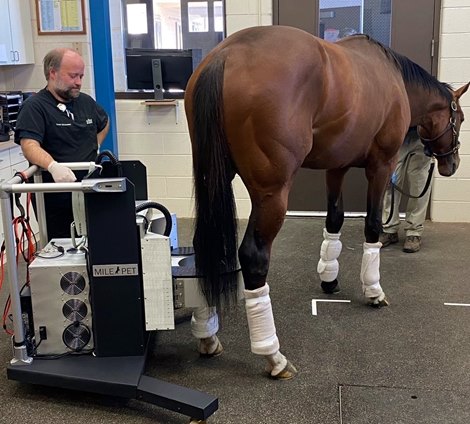The American Association of Equine Practitioners on Oct. 11 published a series of safety recommendations with the goal of complementing the current risk assessment processes already in place for Thoroughbred racing in the United States.
The nine recommendations stem from the inaugural Forum on Thoroughbred Safety & Injury Prevention, hosted by the AAEP on September 29-30 in Lexington, Ky. The meeting convened 23 invited private racetrack practitioners, regulatory veterinarians, surgeons and radiologists to explore additional measures to reduce racehorse injuries.
The forum focused on two key areas: examination of injury data trends from U.S. and international racing jurisdictions, and exploration of new technologies and their potential use for identifying horses at risk for injury.
“The Forum was born out of our desire to help the racing industry at this critical moment for the sport and offer our veterinary expertise to further prevent racehorse injury,” said AAEP Racing Committee chair Dr. Sara Langsam. “Our group believes additional progress comes through identifying the at-risk racehorse that appears outwardly sound but is silently brewing a significant injury. We are hopeful our recommendations will help the racing industry conquer this next frontier of Thoroughbred racehorse safety.”
Safety recommendations are focused on three areas: Identification of the horse at increased risk of injury, improved access to higher-level diagnostic technology, and other means to reduce racehorse injuries. Among the recommendations are:
Sign up for BloodHorse Daily
- Issuance of a request for proposal for the manufacture of a cost-effective wearable biometric sensor. Wearable biometric sensors detect gait changes in the racehorse and can indicate that the horse requires evaluation by its veterinary team. Optimally, these sensors will be used on every racehorse for every high-speed exercise event, including breezing and racing.
- Employment of post-entry screening by regulatory veterinarians to help identify horses at increased risk based on training and racing records. California currently utilizes post-entry screening as an extra layer of scrutiny before race day. This additional step has proven helpful in identifying horses at risk for catastrophic injury.
- Creation of regional PET scan centers at centrally located racetracks throughout the U.S. PET is an advanced imaging modality, and research studies have demonstrated the ability of the PET scan to identify abnormalities associated with an increased risk of injury.
The full list of individual safety recommendations and their rationale, along with a list of Forum on Thoroughbred Safety & Injury Prevention participants, can be found in the event’s report.
This press release has been edited for content and style by BloodHorse Staff.









Leave feedback about this